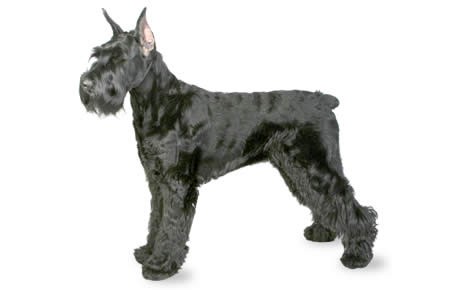Giant Schnauzer Breed Guide

Breed Group:
Working Dogs
Get 30% off
Join our Newsletter
Sign Up Today
Giant Schnauzer Background & History
Originating in Germany, the Giant Schnauzer served as a cattle dog during their earliest beginnings. This particular breed is the largest in the schnauzer family and was developed by breeding together the Standard Schnauzer with larger smooth-haired dogs like the Great Dane.
As the years went on, the role of the Giant Schnauzer evolved to take on several different jobs. Aside from their fieldwork in herding, they were also used in the police force, search and rescue, and even drug detection.
It wasn’t until the late 1900’s that these pups were finally recognized by the American Kennel Club. Even today, the Giant Schnauzer remains an unfamiliar breed in the United States and is lesser known compared to the other Schnauzer variety.
Giant Schnauzer Temperament & Personality
Loyal, courageous, and hardworking are the main characteristics of the Giant Schnauzer breed. Another defining trait is their bold and dominant personalities. An experienced owner is highly recommended for handling this breed. If they do not have a firm owner to follow, they will take advantage of the situation and try to run the household. At the end of the day, all a Giant Schnauzer wants is to be with their family and the ones they love.
This breed also takes their watchdog duties very seriously and will serve as the protector of the household when given the opportunity. While they are not violent animals, they are great at alerting the rest of the home if an intruder or stranger is present.
Giant Schnauzer Training
The Giant Schnauzer is an intelligent breed, however, they need some serious training to hone their skills. Through consistent training and socialization, you will be able to have a well-mannered and obedient companion.
Since this breed is used to having a job, it is very important that they are given extra training practices. Lure coursing and obedience training are both excellent activities to get your Giant Schnauzer involved in. Not only will this test their mental ability to its fullest potential, but it’s also a great way for the owner to bond with their furry friend.
Giant Schnauzer Exercise Needs
This dog is built for endurance and requires the proper exercise to fulfill this need. That’s why it’s imperative that your Giant Schnauzer receives physical activity on a daily basis. This breed should get an hour of vigorous exercise at the minimum, and if they don’t, they may become bored and restless.
Once boredom sets in, your Giant Schnauzer will find his own entertainment by chewing up your living room furniture or tearing up your garden in the backyard. This can easily be prevented with sufficient exercise and attention.
Giant Schnauzer Lifespan
The typical Giant Schnauzer lifespan is anywhere between 12 to 15 years.
Giant Schnauzer Breed Popularity
Like said before, the Giant Schnauzer has never been a popular breed within the United States, unlike the other Schnauzer variety. Today, the Giant Schnauzer is ranked 79th on the American Kennel Club’s list of most popular breeds in the United States.
Giant Schnauzer Feeding Requirements
As you can probably assume, the Giant Schnauzer has an appetite to match their massive size. This breed should consume between 3 ½ to 4 ½ cups of high-quality food on a daily basis, split into two equal meals. This may vary depending on the dog’s size, age, activity level, and metabolism.
Giant Schnauzer Grooming
Just like with the other Schnauzer varieties, these dogs are characterized by their thick wiry coat, intense eyebrows and beard, and their black or peppered coloring. When it comes to a grooming regimen, it is recommended to brush their coat several times a week to avoid matting. They also need to have their nails trimmed on a regular basis to prevent overgrowth or infection. Lastly, brush their teeth weekly to rid their mouth of any bacteria or tartar buildup.
Giant Schnauzer Good With Kids?
Since this breed can have overbearing and controlling personalities, they are not well-suited for a household with children. It is recommended that the child is over the age of 12 so they know how to properly treat and care for a larger-sized animal. Just like with any breed, it’s very important that a parent is present during any interactions between a pet and child.
Giant Schnauzer Health Problems
Although the Giant Schnauzer is a generally healthy breed, they are still at risk for developing many health complications. Possible Giant Schnauzer health problems may include:
Osteochondrosis Dissecans (OCD): OCD in dogs is a disorder that causes stiffening of the joints in the shoulders and elbows. When this hereditary problem occurs, dogs will be in pain and may not be able to bend their affected elbow.
Squamous Cell Carcinoma: Squamous Cell Carcinoma is cancer that affects a dog’s toes. Symptoms will start with the dog becoming lame and unable to move. If you believe your dog has Squamous Cell Carcinoma, take him to the vet as soon as possible.
Autoimmune Thyroiditis: This hereditary condition is the main cause of hypothyroidism in Giant Schnauzers. Hypothyroidism occurs when the dog has insufficient levels of thyroid hormones, causing a fluctuation in weight, low appetite, infertility, and a change in their coat.
Other Resources
National Breed Website: Giant Schnauzer Club of America
Rescue: Giant Schnauzer Rescue Network
Health Issues Associated with this Breed:
- Autoimmune Thyroiditis
- Hip Dysplasia
- Inflammation
- Mast Cell Tumors
- Osteochondrosis
- Pain
- Squamous Cell Carcinoma





